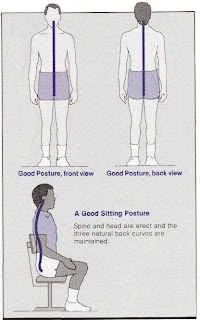T o have good posture, it is essential that your back, muscles, and joints be in tip-top shape.
Your Back. A healthy back has three natural curves: a slight forward curve in the neck (cervical curve), a slight backward curve in the upper back (thoracic curve), and a slight forward curve in the low back (lumbar curve). Good posture actually means keeping these three curves in balanced alignment.
Your Muscles. Strong and flexible muscles also are essential to good posture. Abdominal, hip, and leg muscles that are weak and inflexible cannot support your back’s natural curves.
Your Joints. Hip, knee, and ankle joints balance your back’s natural curves when you move, making it possible to maintain good posture in any position. A View of Good Posture;
A View of Good Posture;

Poor Posture
P oor posture distorts the body’s proper vertical alignment and the back’s natural curves.
Good posture only has one appearance, but poor posture comes in many unattractive styles.

Check Your Posture
T he best way to check your posture is to receive a thorough postural evaluation from a physical therapist. Physical therapists have special skills to evaluate and treat postural problems.
To determine if a professional evaluation may be necessary, you can evaluate your own posture to some degree. For this you need a wall and a fulllength mirror.
To check for normal curves of the spine:
Stand with your back to a wall, heels about three inches from the wall. Place one hand behind your neck, with the back of the hand against the wall, and the other hand behind your low back with the palm against the wall. If there is excessive space between your back and the wall, such that you can easily move your hands forward and back more than one inch, some adjustment in your posture may be necessary to restore the normal curves of your spine.


No comments:
Post a Comment